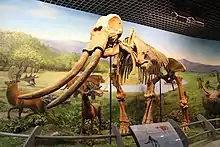Palaeoloxodon naumanni
Palaeoloxodon naumanni, occasionally called Naumann's elephant,[1] is an extinct species belonging to the genus Palaeoloxodon that was endemic to the Japanese archipelago during the Middle to Late Pleistocene around 430,000 to 24,000 years ago. It is named after Heinrich Edmund Naumann who discovered the first fossils at Yokosuka, Kanagawa, Japan.
| Palaeoloxodon naumanni | |
|---|---|
 | |
| Scientific classification | |
| Kingdom: | Animalia |
| Phylum: | Chordata |
| Class: | Mammalia |
| Order: | Proboscidea |
| Family: | Elephantidae |
| Genus: | †Palaeoloxodon |
| Species: | †P. naumanni |
| Binomial name | |
| †Palaeoloxodon naumanni (Makiyama, 1924) | |
| Synonyms | |
| |
Description

Palaeoloxodon naumanni, like other members of the genus Palaeoloxodon, is more closely related to African elephants than Asian elephants and Mammoths.[2] Similar to mammoths P. naumanni had a subcutaneous fat layer and long fur as an adaption to a cold environment.[3] The species had a pair of long twisted tusks and a bulge on the head.[3] These tusks grew more than 2.4 m in length, 20 cm in diameter.[4] It was a little smaller than Asian elephants averaging 2.5 metres (8.2 ft) to 3 metres (9.8 ft). It lived in forest which mixed subarctic conifers and cool-temperate deciduous trees.[5]
The ancestor of Palaeoloxodon naumanni moved from the Eurasian continent to Japan via a land bridge; it subsequently evolved independently and spread throughout Japan after the land bridge was covered by rising seawaters. Palaeoloxodon naumanni was hunted by the inhabitants of the time. Some fossils were found around Lake Nojiri in Nagano Prefecture, together with many lithic and bone tool artifacts.[4]
The range of P. naumanni extends across the Japanese archipelago, north to Hokkaido, where during the Late Pleistocene it alternated with the woolly mammoth during warmer intervals.[6]
Discovery and nomenclature
In 1860, the first fossil record was found at Yokosuka and the bottom of Seto Inland Sea, Japan. Heinrich Edmund Naumann researched and reported these fossils in “Ueber japanische Elephanten der Vorzeit” (1882). Naumann classified the fossil as Elephas namadicus Falconer & Cautley. In 1924, Jiro Makiyama researched fossils which were found in Hamamatsu, Shizuoka and reported the elephant was a new subspecies and deseignated the fossil Elephas namadicus naumannni in “Notes on a fossil elephant from Sahamma, Totomi” (1924). Tadao Kamei identified Elephas namadicus naumanni as a new species, called Palaeoloxodon naumanni, from fossils found at Lake Nojiri. It has also been called Elephas naumanni.[5]
Evolution and extinction
The oldest known dates for the species are from MIS 12, around 430 kya, where it replaces Stegodon orientalis, which had arrived from mainland East Asia several hundred thousand years prior.[7] The youngest dates for the species are around 24 kyr Before Present, during the early stages of the Last Glacial Maximum. Any younger dates were considered unreliable.[8]
See also
References
- Norihisa, Inuzuka; Hasegawa, Yoshikazu; Nogariya, Hiroshi; Kamei, Tadao (31 Jan 1975). "On the Stylohyoid Bone of Naumann's Elephant (Elephas naumanni MAKIYAMA) from Lake Nojiri" (PDF). Memoirs of the Faculty of Science, Kyoto University. Series of Geology and Mineralogy. 41 (1): 49. Retrieved 2 March 2017.
- Palkopoulou, Eleftheria; Lipson, Mark; Mallick, Swapan; et al. (2018). "A comprehensive genomic history of extinct and living elephants". Proceedings of the National Academy of Sciences. 115 (11): E2566–E2574. doi:10.1073/pnas.1720554115. PMC 5856550. PMID 29483247.
- Taga town Museum Archived 2012-02-29 at the Wayback Machine
- 野尻湖と最終氷期の古環境
- "ナウマン象に出会った石器たち「-3万5千年前の石器製作跡か?-」" (PDF). Archived from the original (PDF) on July 22, 2011.
- Takahashi, Keiichi; Soeda, Yuji; Izuho, Masami; Yamada, Goro; Akamatsu, Morio; Chang, Chun-Hsiang (April 2006). "The chronological record of the woolly mammoth (Mammuthus primigenius) in Japan, and its temporary replacement by Palaeoloxodon naumanni during MIS 3 in Hokkaido (northern Japan)". Palaeogeography, Palaeoclimatology, Palaeoecology. 233 (1–2): 1–10. Bibcode:2006PPP...233....1T. doi:10.1016/j.palaeo.2005.08.006.
- YOSHIKAWA, Shusaku; KAWAMURA, Yoshinari; TARUNO, Hiroyuki (March 2007). "Land bridge formation and proboscidean immigration into the Japanese Islands during the Quaternary" (PDF). Journal of Geosciences, Osaka City University. 50: 1–6.
- Iwase, Akira; Hashizume, Jun; Izuho, Masami; Takahashi, Keiichi; Sato, Hiroyuki (March 2012). "Timing of megafaunal extinction in the late Late Pleistocene on the Japanese Archipelago". Quaternary International. 255: 114–124. Bibcode:2012QuInt.255..114I. doi:10.1016/j.quaint.2011.03.029.
External links
| Wikimedia Commons has media related to Palaeoloxodon naumanni. |
